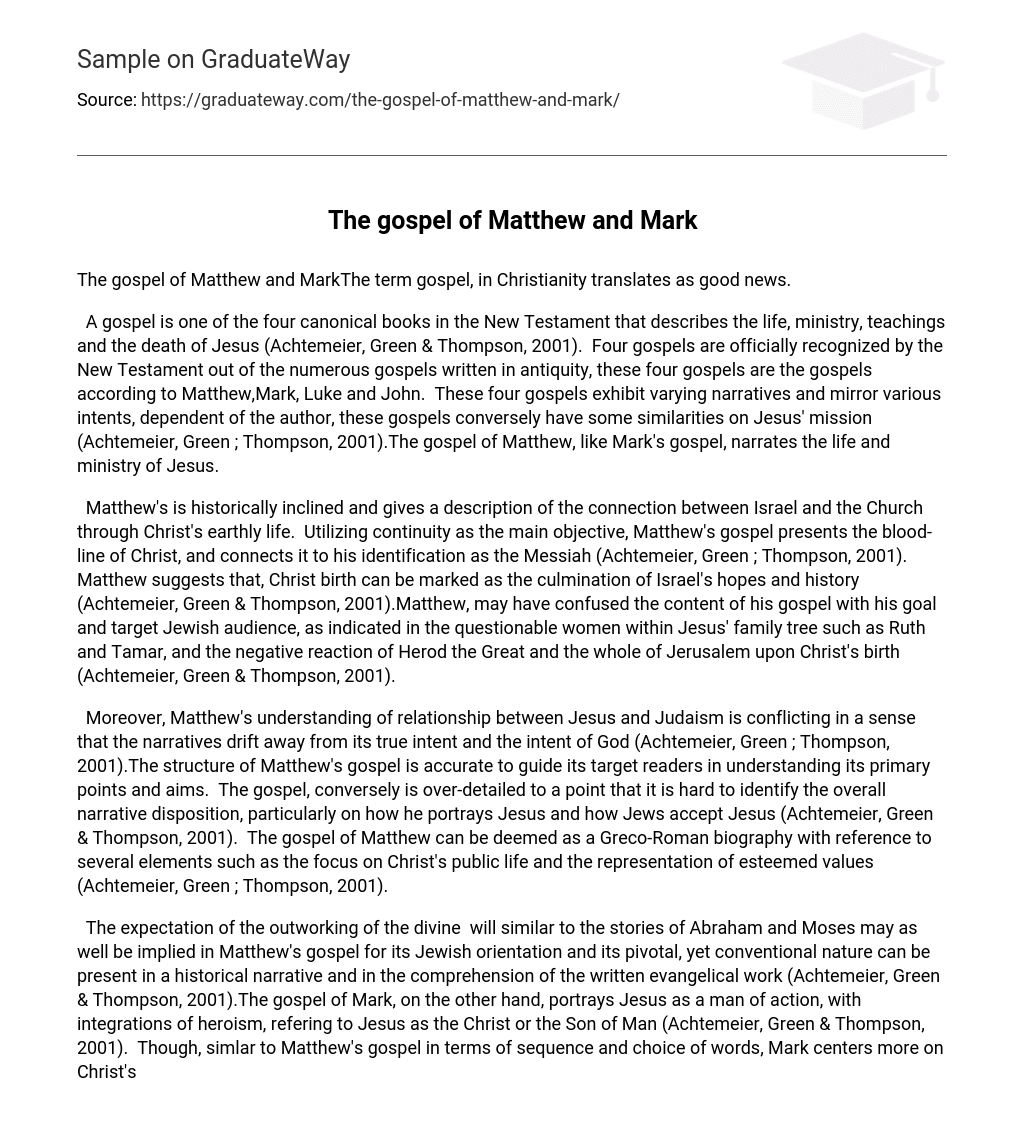The gospel of Matthew and MarkThe term gospel, in Christianity translates as good news.
A gospel is one of the four canonical books in the New Testament that describes the life, ministry, teachings and the death of Jesus (Achtemeier, Green & Thompson, 2001). Four gospels are officially recognized by the New Testament out of the numerous gospels written in antiquity, these four gospels are the gospels according to Matthew,Mark, Luke and John. These four gospels exhibit varying narratives and mirror various intents, dependent of the author, these gospels conversely have some similarities on Jesus’ mission (Achtemeier, Green ; Thompson, 2001).The gospel of Matthew, like Mark’s gospel, narrates the life and ministry of Jesus.
Matthew’s is historically inclined and gives a description of the connection between Israel and the Church through Christ’s earthly life. Utilizing continuity as the main objective, Matthew’s gospel presents the blood-line of Christ, and connects it to his identification as the Messiah (Achtemeier, Green ; Thompson, 2001). Matthew suggests that, Christ birth can be marked as the culmination of Israel’s hopes and history (Achtemeier, Green & Thompson, 2001).Matthew, may have confused the content of his gospel with his goal and target Jewish audience, as indicated in the questionable women within Jesus’ family tree such as Ruth and Tamar, and the negative reaction of Herod the Great and the whole of Jerusalem upon Christ’s birth (Achtemeier, Green & Thompson, 2001).
Moreover, Matthew’s understanding of relationship between Jesus and Judaism is conflicting in a sense that the narratives drift away from its true intent and the intent of God (Achtemeier, Green ; Thompson, 2001).The structure of Matthew’s gospel is accurate to guide its target readers in understanding its primary points and aims. The gospel, conversely is over-detailed to a point that it is hard to identify the overall narrative disposition, particularly on how he portrays Jesus and how Jews accept Jesus (Achtemeier, Green & Thompson, 2001). The gospel of Matthew can be deemed as a Greco-Roman biography with reference to several elements such as the focus on Christ’s public life and the representation of esteemed values (Achtemeier, Green ; Thompson, 2001).
The expectation of the outworking of the divine will similar to the stories of Abraham and Moses may as well be implied in Matthew’s gospel for its Jewish orientation and its pivotal, yet conventional nature can be present in a historical narrative and in the comprehension of the written evangelical work (Achtemeier, Green & Thompson, 2001).The gospel of Mark, on the other hand, portrays Jesus as a man of action, with integrations of heroism, refering to Jesus as the Christ or the Son of Man (Achtemeier, Green & Thompson, 2001). Though, simlar to Matthew’s gospel in terms of sequence and choice of words, Mark centers more on Christ’s identity, ministry and the nature of discipleship. Generally, Mark lays down Jesus’ Ministry in a progressive manner, with more emphasis on the last few weeks of Christ’s earthly career, blatantly integrating Jesus’ Ministry to his suffering and death (Achtemeier, Green ; Thompson, 2001).
A notable difference from the gospel of Matthew is that Mark summarizes Jesus prior to his baptism and gives a detail writing of Christ’s public career and the will of God through the identity of Jesus Christ, as a powerful teacher and miracle worker (Achtemeier, Green & Thompson, 2001).A deeper analysis on Mark’s gospel reveals an important element, his main intention and the main grounds for his narrative: speaking on behalf of God. Mark differs from Matthew in representing Jesus and his life(Achtemeier, Green ; Thompson, 2001). Mark focuses on the premise of Jesus’ public life and does it in such a way that he integrates divinity in Jesus’ acts (Achtemeier, Green ; Thompson, 2001).
In reference to style, Mark could have deipcted Christ in other forms such responses to social struggles, for instance, Paul’s letters, however, the narrative form of writing primarily has unique qualities that acquaint the reader of the main chracter, in this case, Christ and the deeper meaning discipleship. Second is the use of underlying forces mold the lives of character in the narrative and the story itself, lastly is the narrative’s natural function to attract its audience to strengthen shared values or challenge their imaginations along with their thoughts and practices. Such qualities are all present in Mark’s gospel as his gospel is buckled with Christ’s identity (Achtemeier, Green ; Thompson, 2001).Mark and Matthew present their gospels with similarities and differences.
Personally, I am compelled by how the evangelist Mark wrote the gospel. It is true that he has no emphasis of Christ’s life prior to his ministry, however, Mark wrote the Gospel with consideration to the divine will of God, which is the purpose of the sacred scriptures and Christ’s mortal exixtence in the first place. Mark’s intentions tend to be more of for universal audience rather than a selected few. Furthermore, in his version, Mark made it distinct in such a way that it has an underlying concept that seperate itself from the traditional dogma of society.
ReferencesAchtemeier, P.J., Green, J.B.
& Thompson, M.M. (2001). Introducing the New Testament: Its Literature and Theology.
Michigan: William B. Eerdman’s Publishing Company.;





